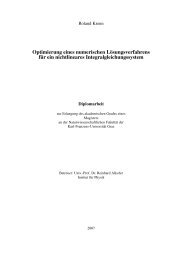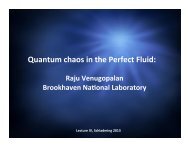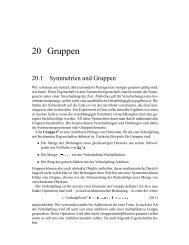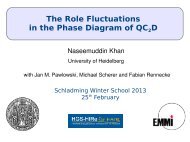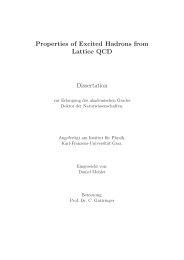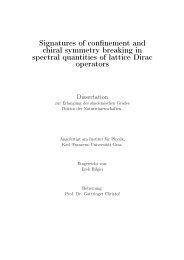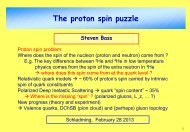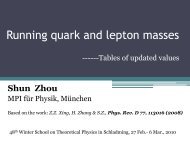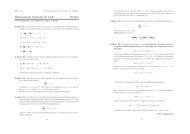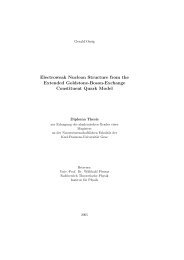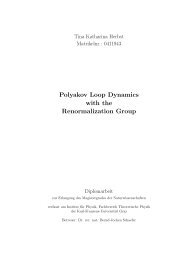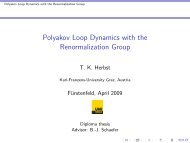The QCD Quark Propagator in Coulomb Gauge and - Institut für Physik
The QCD Quark Propagator in Coulomb Gauge and - Institut für Physik
The QCD Quark Propagator in Coulomb Gauge and - Institut für Physik
You also want an ePaper? Increase the reach of your titles
YUMPU automatically turns print PDFs into web optimized ePapers that Google loves.
Chapter 6. Nucleon Form Factors <strong>in</strong> a Covariant Diquark-<strong>Quark</strong> model 83<br />
Table 6.5: Row 1 – static properties calculated with set B diquark masses, table 6.1, <strong>and</strong><br />
µ 1 + = 2, χ 1 + = 1, κ T = 2: charge radii <strong>in</strong> fm, with r n def<strong>in</strong>ed <strong>in</strong> table 6.2; <strong>and</strong> magnetic<br />
moments <strong>in</strong> nuclear magnetons, [AHK + 05]. Row 2 adds the corrections of equations(6.95)–<br />
(6.97) with λ = 0.3 GeV. ς <strong>in</strong> row n, is the rms relative-difference between the entries <strong>in</strong> row<br />
n <strong>and</strong> 3.<br />
r p r n r p µ r n µ µ p −µ n ς<br />
q-(qq) core 0.595 0.169 0.449 0.449 3.63 2.13 0.39<br />
+π-loop correction 0.762 0.506 0.761 0.761 3.05 1.55 0.23<br />
experiment 0.847 0.336 0.836 0.889 2.79 1.91<br />
equations(6.90) <strong>and</strong> (6.91) are rewritten<br />
〈r 2 p 〉 1−loopR<br />
NA n<br />
〈(r µ N )2 〉 1−loopR<br />
NA<br />
(µ p n )1−loopR NA<br />
= ∓ 1 + 5g2 A<br />
32π 2 f 2 π<br />
= − 1 + 5g2 A<br />
32π 2 f 2 π<br />
= ∓ g2 A M N<br />
4π 2 f 2 π<br />
m 2 π<br />
ln(<br />
m 2 π + λ2) , (6.95)<br />
m 2 π<br />
ln(<br />
m 2 π + λ2) + g2 A M N 1 2<br />
16πfπ 2µ v m π π arctan( λ ) ,<br />
m π<br />
(6.96)<br />
2 λ3<br />
m π arctan( ) , (6.97)<br />
π m 3 π<br />
where<strong>in</strong> λ is a regularisation mass-scale, for which a typical value is ∼ 0.4 GeV [ALTY04].<br />
As required the loop contributions vanish when the pion mass is much larger than the<br />
regularisation scale: very massive states must decouple from low-energy phenomena.<br />
We return now to the calculated values of the nucleons’ static properties, tables 6.2–<br />
6.4, <strong>and</strong> focus on the set B results obta<strong>in</strong>ed with µ 1 + = 2, χ 1 + = 1, κ T = 2. Recall that<br />
set B was chosen to give <strong>in</strong>flated values of the nucleon <strong>and</strong> ∆ masses <strong>in</strong> order to make<br />
room for chiral corrections, <strong>and</strong> therefore one may consistently apply the corrections <strong>in</strong><br />
equations(6.92), (6.95) <strong>and</strong> (6.96) to the static properties. With λ = 0.3 GeV this yields<br />
the second row <strong>in</strong> table 6.5: the regularised chiral corrections reduce the rms relativedifference<br />
significantly. This crude analysis suggests that a veracious description of baryons<br />
can be obta<strong>in</strong>ed us<strong>in</strong>g dressed-quark <strong>and</strong> -diquark degrees of freedom augmented by a<br />
sensibly regulated pseudoscalar meson cloud.



